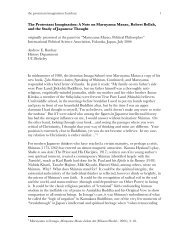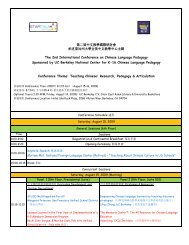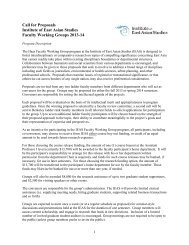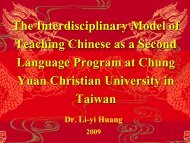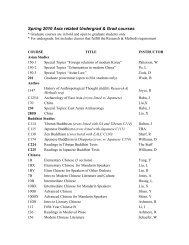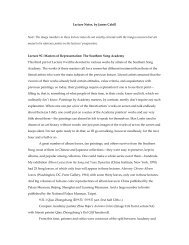Third Edition Spring 2013 - Institute of East Asian Studies, UC ...
Third Edition Spring 2013 - Institute of East Asian Studies, UC ...
Third Edition Spring 2013 - Institute of East Asian Studies, UC ...
You also want an ePaper? Increase the reach of your titles
YUMPU automatically turns print PDFs into web optimized ePapers that Google loves.
known and as relevant as it deserves by making resources aboutthe Arthashastra more widely available in the world, and by encouragingresearch and discussion on Kautilya and the Arthashastra.Perhaps this discussion may expand the Arthashastra’s reachbeyond the scope <strong>of</strong> Indian nationalism, Western business, and theschools <strong>of</strong> Western thought with which it shares many similarities.Kautilya and the Arthashastra certainly have the potential make asignificant impact upon a variety <strong>of</strong> fields not directly addressed inthis paper.Unfortunately, as <strong>of</strong> today Kautilya and his famous Arthashastraare still little known outside <strong>of</strong> South Asia and South <strong>Asian</strong><strong>Studies</strong>. This is despite the fact that Kautilya not only anticipatedthe ideas <strong>of</strong> Western thinkers like Machiavelli and Adam Smith, butcombined the concepts <strong>of</strong> realpolitik and classical economics intoa single text distinct from its European counterparts. In fact, Kautilya’slinking <strong>of</strong> politics and economics is perhaps the greatest aspect<strong>of</strong> the Arthashastra. In discussing the concept <strong>of</strong> good governanceby the ideal state “Kautilya equates political governance with economicgovernance” where “the end is economic governance whilepolitical governance is a means.” 34 Just as in Machiavellian politics,the concept <strong>of</strong> the “end justifies the means” is a basis for Kautilyanthought. Good governance in a Kautilyan sense, then, whether politicalor economic, is about “justifying the ends and means as thesocio, economic, and political conditions demand.” 35Because the Arthashastra is distinct from its Western counterpartsin its synthesis <strong>of</strong> the ideas <strong>of</strong> realpolitik and classical economicsinto the single concept <strong>of</strong> good governance, Kautilya’s textdeserves a place among the world’s great political and economictreatises. More importantly, the works <strong>of</strong> Starzl and Dhir, Kumarand Rao, and a number <strong>of</strong> other scholars have shown that the Arthashastrais neither outdated, nor strictly theoretical; it does infact have applications to the modern world <strong>of</strong> corporations and bigbusiness. However, as Kautilya’s work is still relatively unknown—especially in comparison to other <strong>East</strong>ern texts that have beeninfluential in business, such as The Art <strong>of</strong> War and the BhagavadGita—most CEOs have yet to employ Kautilya’s strategies. Withmore research on the Arthashastra’s relevance and more time forthe text to gain popularity, the Arthashastra may become more influentialin the corporate world. When the Arthashastra does earnits rightful place in the personal libraries <strong>of</strong> political theorists,economists, world leaders, and CEO’s alike for its ideas on statecraftand economic policy and its applicability to modern corporations,the Arthashastra will finally be recognized for its contributionto human knowledge. Only then will the legacy <strong>of</strong> Kautilya andhis famous treatise be permanently cemented in history, ensuringthat the Arthashastra will never again be lost to the world.34 Kautilya’s Arthashastra: Its Contemporary Relevance, (Pune: Indian Merchants’Chamber & Indian Merchants’ Chamber Economic Research and Training Foundation,2005), 73.35 Ibid.67 Ramanathan Veerappan Kautilya’s Arthashastra 68




